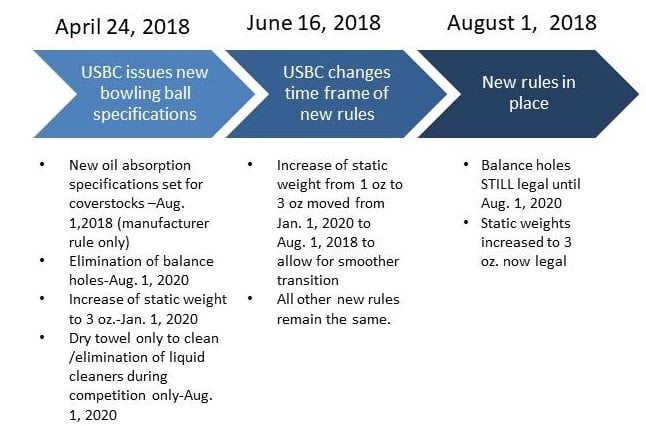The 2018 USBC Balance Hole Specification Update
bowlingball.com
7/6/2018As a bowler, you may have heard of all the recent changes with bowling ball specifications from USBC. No more balance holes! But what does that mean for your bowling future and your equipment? Fear not! We are here to help break things down and explain. Let’s start from the top.
The USBC, United States Bowling Congress, is the National Governing Body and membership organization for bowling that provides standardized rules, regulation and benefits. Throughout the course of bowling history, changes in rules and advances in equipment technology have impacted the sport, threatening the integrity of bowling, according to the USBC Specifications and Certifications team.
After a few years of careful research regarding new bowling ball technology and its effect on the sport, USBC has unveiled some new specifications designed specifically to conserve bowling’s integrity, both now and for the future...
The USBC places specification limits on the weight of bowling balls, including static weights after drilling. What are static weights you ask? Static weights in a bowling ball are the total weight and the imbalances measured on a scale when the bowling ball is at rest. Static weights consist of top, bottom, finger, thumb and side weights. All of these together are a small part of what helps produce the typical three-phase motion of a bowling ball: skid, hook and then roll. Without the control of the static weights, the ball could likely produce an unwanted, unpredictable motion like skid, hook, roll then possibly hook again. That may be fun for some but may cause serious bowlers some serious headaches...
Occasionally, a bowling ball balance hole, a non-gripping hole, is drilled into the bowling ball to get the ball within the USBC specifications for imbalance (static balance). By drilling this additional hole into the ball in a specific location, this removes extra weight thus making the ball USBC legal. Balance holes can be drilled at varying depths, diameters and locations to achieve the legality. Balance holes are a very common sight to see on manufacturer layouts and even the bowling balls used by pro bowlers.
Up until August 1, 2018, static weight and balance hole specifications for bowling balls were as follows: (Section 1)
- -A maximum of 3 oz. of top or bottom weight, and 1 oz. each of side, finger or thumb weight.
- -A ball may have one hole for balance purposes, not to exceed 1 ¼ inches in diameter at any point through the depth of the hole.
As of August 1, 2018, the new rules below have been implemented: (Section 2)
- -A maximum of up to 3 oz. of top or bottom weight and up to 3 oz. of static weight, thumb or finger weight and, provided the ball does not have a balance hole.
- -Balls may still have a balance hole until August 1, 2020, but any balls with a balance hole must stay within the current static weight specification of 1 oz. per finger, thumb or side weight, and 3 oz. for top or bottom weight.
After August 1, 2020, any and all balance holes must be plugged (filled). Bowlers are allowed up to five holes for gripping purposes but each hole must be used every delivery. A bowler who chooses not to use a thumb hole will scribe the intended center of palm with a plus (+) mark to indicate grip orientation.
If you plan on purchasing a new ball before August 1, 2020, you have two options: #1) Drill the ball without the balance hole in accordance to new USBC rules (as seen in Section 2) or #2) Drill the ball with the balance hole in accordance to older USBC rules (as seen in Section 1).
So, what does all of this mean for you and your current equipment?
- -If you currently have balls drilled with balance holes in them, you may use them legally until August 1, 2020. You will have until that date (August 1, 2020) to plug any additional non-gripping holes. (This includes drilled thumb holes for no-thumb bowlers, as that is technically not a gripping hole used each delivery.)
- -If you don’t have balance holes drilled in your ball? Just keep up the great bowling! Your ball will still be legal.
Also something to keep in mind, these rules only apply to those who bowl in USBC sanctioned leagues and/or tournaments. If you are a recreational bowler or bowl in a non-sanctioned league, these rules do not necessarily apply unless you plan to bowl in USBC leagues or tournaments.
bowlingball.com continues to offer you our top-of-the-line Custom Drilling service and will allow you the option to choose whether you would like your new ball to have a balance hole drilled or not prior to August 1, 2020. After that date, all drillings will cease to have balance holes.
Here is a timeline of when the USBC announced the new rules, made a revision and the date they go into effect:

As bowlers ourselves, we definitely understand everyone’s questions and concerns regarding these new rules. We hope that we were able to answer all your questions. If not, please leave us a comment below and will would be happy to discuss with you.
Thank you for all your support here at Bowlversity on bowlingball.com. It’s where bowlers go!

